Chinese designer Cao Wei is awarded World Design Award in Italy
According to Xinhua:December 16, 2008.Cao Wei is director of the Capital City Commerce & Urban Planning Design Academy in Beijing, China.For some years now he has been working to fuse traditional Chinese culture and modern urban development.The award he has been granted is from the Italian Academy of Fine Arts of Lecce and Italy’s FUCINA in a jointly sponsored cultural competition: the Traditional and Modern (Architettura Artistica: Tradizione e Modernità). The award is in recognition of his Kirin Bay Business Street project in Xining, Qinghai Provice, China.
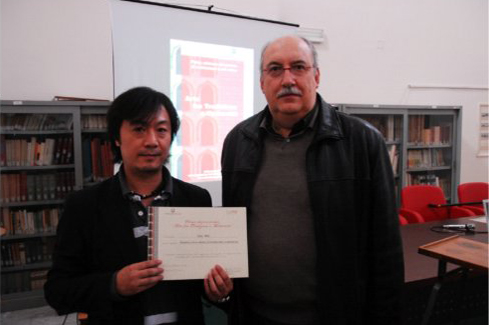 At the door of the Academy of Fine Arts in Lecce, Italy, Cao Wei with the former mayor and the College Principal, Mr. Giacinto Leone. At the door of the Academy of Fine Arts in Lecce, Italy, Cao Wei with the former mayor and the College Principal, Mr. Giacinto Leone.
The event began a month before with a survey of global works after a jury selection.On December 16 Cao Wei was chosen as a finalist from among designers in China, Italy and France.Finalists were honored by the former mayor of Lecce, Italy who is currently President of the Academy of Fine Arts, Giacinto Leone, who personally presented Mr. Cao Wei the honorary certificate.
The event has been organized to further protect and promote culture lost amidst rapid development.Italy shares thousands of years history, and preserving culture and art has a special significance in the ancient Roman city of Lecce.
In his acceptance speech, delivered in English, CAO Wei said, “I was very happy to participate in activities aimed at furthering understanding of eastern and western design.Outside of China I have been able to better appreciate not only international standards, but the feelings of Italian and international designers.In addition it is also exciting to have the opportunity to further design perceptions from China's traditional culture.The design I worked on will be implemented in China’s northwest, and make full use of traditional art from Qinghai’s diverse culture, while modernizing these styles to create a fashionable shopping mall.Using some elements even of Turkish urban landscape design, I focused on avoiding monotony in space, allowing every shop to impress unique design elements on visitors.”
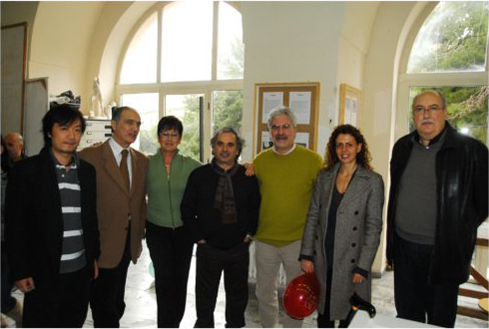 It sounds like a truly wonderful experience Cao Wei had in Lecce, where over a thousand years of history, and the Academy of Fine Arts, and FUCINA, judges and experts could together exchange ideas and their passion. It sounds like a truly wonderful experience Cao Wei had in Lecce, where over a thousand years of history, and the Academy of Fine Arts, and FUCINA, judges and experts could together exchange ideas and their passion.
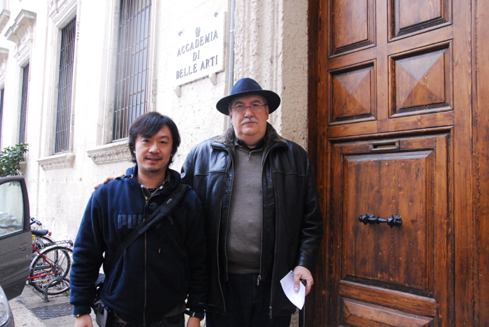
At the door of the Academy of Fine Arts in Lecce, Italy, Cao Wei with the former mayor and the College Principal, Mr. Giacinto Leone.
Interview Capital City Commerce & Urban Planning Design Academy of designer Cao Wei
Character brief introduction:
CAO WEI,Country-level Landscape Architect,The national level, urban planner,Access to the U.S. Environmental Landscape Planner,Macau Asia National Open University MBA Master of Business Administration,Part-time professor at Beijing Vocational College of Finance and Trade,Co-authored, "Commercial Network Structures” and "Commercial Layout and Store Design”;Vice president of Capital City Commerce & Urban Planning Design Academy,2008 Named among the hundred most influential people in China’s construction planning and design industry,2008 China's gold standard in green building planning and design planning award.
Cao Yuanzhang: first can you tell us a little about your Institute.
Cao Wei: This is a research institute that seeks to improve upon international progress in modern urban planning and design. We try to think deeply on the intersection between cultural and commercial success and how to advance this through planning and design concepts.We have a strong team of senior experts and designers who can bring together a wide range of experience in urban commercial design projects.We tend to focus on integrated designs to address not only marketing planning, commercial planning, store layout planning, business logistics systems planning, but also specific business planning, business management consulting, urban commercial planning, commercial design to achieve a unity of purpose leading to achievements of various goals depending on the local environment’s needs.
Cao Yuanzhang: As an institute which over the years has won numerous illustrious government contracts, could you briefly enlighten us on its history?
Cao Wei: Well, first our business developed first under the auspices of the Ministry of Commerce of the PRC in order to refine their protocols for "urban commercial network planning and management regulations".Our team then moved on to complete contracts on three business parks in Beijing's Chaoyang District.From there we have done design and planning in Shanghai, Guangzhou and many other well-known commercial projects including Beijing, Huainan City, Hangzhou, Chongqing, Weihai City, Pingliang City, Xining City, Jilin, Shenyang, Nanning, Beihai City, Yiwu City, and about 27 other metropolitan and regional commercial design projects.In Beijing we have worked on the Beijing Zhongguancun Science Park, Beijing CBD, Asia Standard commercial and special programs for the planning of studies, including Beijing Wangfujing, Xidan, Qianmen commercial street, Silk Street, Sanlitun Bar Street, Xicheng.Some other projects that come to mind are the Financial Street, Shanghai, Nanjing Road, Guangzhou Zhongshanwu Road, Beijing Road, Harbin, Central Street, Nanjing Hunan Road, Changsha, Huang Xing Road, Bengbu District huaxia commercial street – many commercial street projects in which we take into account environmental as well as logistic and commercial issues to help the large enterprises that will use the space to conduct overall marketing strategy design.
Cao Yuanzhang: Can we talk about your current feelings about the winning the award in Lecce, Italy.
Cao Wei: I felt quite emotional about it, due to the authenticity of the institutions involved.During the Q & A process the judges were thought provoking, raising specific issues.I was fascinated by their concerned for the materials and the processes involved, which, alongside the concept, they felt would affect the finished environment.I was also impressed by a favoring of designs with fewer elements.The Italian design teams carefully and rigorously reduced every process achieve simplicity in conception, construction, and design effect.The academic awards they offered always favored simplicity.I came to understand that in Italy design is fully appreciated from as a complete process, from the way they treat nature to the integrity and rigor that becomes evident when discussing even the smallest design detail.One could say that they do not just care about the surface of the packaging.
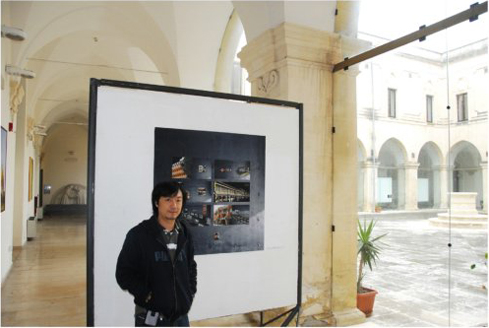
Can we talk about Italian design and how it differs from Chinese design.
Cao Wei:I deeply feel that I learned a lot about process, but more importantly I am inspired to respect and learn more.There was an overall atmosphere of respect, which made me feel great.The judges had great respect for every ideas.There was almost no sense of competition or examination.Experts and professors rarely raised objections to a participant’s answer, but rather assumed everyone was a serious designer, and so they only wanted to understand and absorb the ideas in the way a designer conceived them.Even among among members of the public one could feel a deep respect for art and design as an art.In China like in Europe designers are very proud of their own design, and in the course of presentations, maybe less so that in China, presenters did not have any modesty but rather excitement.However at the design show and conference there was always an adherence to a philosophy, and any particular design work was built from or expressed a few very bold ideas.I would like to have such self-respect and self-confidence while coupling it with respect for different ways of thinking through design issues.It may well be cultural tolerance that makes Italy's innovation and design unique in the world..
Cao Yuanzhang: Can tell us about your work in this competition does.
Well, what I would particularly like to talk about is in the work in terms of the history of natural and cultural heritage. What we did was augment a park by adding commercial space, a mall essentially, while renewing the original park at the same time.The local government told us, concerning the original park sculptures and landscape that we could reinvent the wheel, specifically they wanted more modern, bright elements. But without disagreeing, I sought to retain the original design as much as possible.I recall saying at the inauguration, "I also hope that local people continue to remember the park, which is a city treasure and can not be copied."
In China, more so than anywhere in the world today, the same architecture is being reproduced and copied in different cities.Much construction reflects nothing of regional culture. I wanted to forget every other park I’d seen, and actually during the design process of Kirin Bay Street project, I collected and listened constantly to folk songs of Qinghai, seeking inspiration, the music I wanted in the air.I travelled around Qinghai and shot photos of local residents and temples, discovering things like Hehuang rhyme, which I incorporated into slots in the design.Overall I think there a thickness to the rustic culture in Qinghai that I wanted to come out of the park.Some other examples are a specific kind of flower many local houses have carved in their walls.The farmers call this ‘bread flower’, and it is beautiful.I continued this tradition by etching these flowers in the wall.In addition, there is a traditional "horse wall" which was applied in the design details.
The Kirin Bay Street is a commercial children's park, along the Nanchuan River.It has poplar trees more than 270 hundred years old.A local I spoke with mentioned childhood memories of the way the green leaves sway against the blue sky in the summer.I wanted to make sure this memory could be recreated by future generations.The park also had simple animal sculptures, which for some residents was also a source of happiness. While the city wanted commercial space added to the park, it was important that the original park was the the most prominent aspect in the layout.We included a clock run by water, and insisted on keeping the original meandering river because water is so rare in the arid environment.But we could commercialize this area with "Water Fun" businesses.You can be smart with business, nature and culture, and combined them.
In a city with limited resources and a bottom line, it is indeed difficult to deal with nature and the development of the relationship between tradition and innovation, but for me to feel good about a project design, the search for the most beautiful results in just this.I hope my designs in the future will be able to retain even more of the nature and tradition.
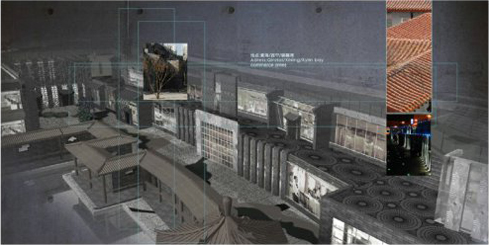 China songzhuang Net: So what would you say is the difference between foreign and China's urban construction China songzhuang Net: So what would you say is the difference between foreign and China's urban construction
The biggest difference is in the time frame from conception to completion of construction.While Chinese design has made many breakthroughs, foreign designers do pay more attention to the pre-program, conceiving and modelling and re-conceiving - not that they do not attach importance to the construction plans and construction process, as well as quality and safety aspects.But in the early stages, the process proceeds deliberately and with discussion and oversight that many Chinese firms find wasteful, but the fact is that if later in the process problems arise, to come back and solve them creates costs in time and materials, etc that are often higher.Abroad there is also the public scrutiny of urban projects which can be a hassle, but it also ensures deliberate and articulate conceptions.Abroad pre-planning often takes a long time, rarely quicker than three years, and sometimes up to a decade.In China there is often a superior’s demand that a project be completed and running within the year, and there is less respect for the need to give designers a relaxed schedule during which phases in overal thinking can be completed.Because superiors in these projects often do not understand the fundamental urban design issues, they are ill-equipped to helpfully comment.Lastly abroad there seems to be a sense of great joy in discovering solutions to particular problems encountered in the pre-design process.I in general these are important aspects for any program design and planning stage, to encourage play and debate and adjustment, and not to see this as wasteful.In terms of the quality of the implementation for the project as a whole there is more time taken.
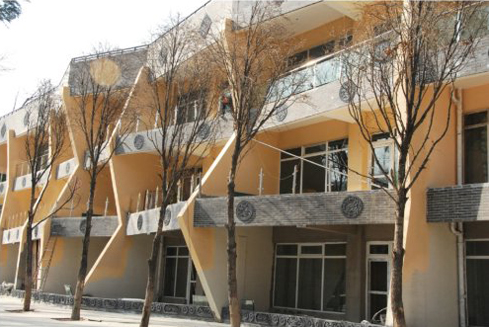 In 2008 the Italian Academy of Fine Arts of Lecce and Italy FUCINA jointly sponsored cultural institutions: the traditional and modern (Architettura Artistica: Tradizione e Modernità) the selection of the activities of art and design show only the best design award. From Lecce former mayor and school principal, Mr. Giacinto Leone personally awarded honorary certificates. In 2008 the Italian Academy of Fine Arts of Lecce and Italy FUCINA jointly sponsored cultural institutions: the traditional and modern (Architettura Artistica: Tradizione e Modernità) the selection of the activities of art and design show only the best design award. From Lecce former mayor and school principal, Mr. Giacinto Leone personally awarded honorary certificates.
http://www.bjccca.com/caoyuansuohuojiangxiang.htm

Cao Wei is awarded World Design Award in Italy.
 Sina reports Sina reports
 Sohu reports Sohu reports
 Other reports Other reports
|


